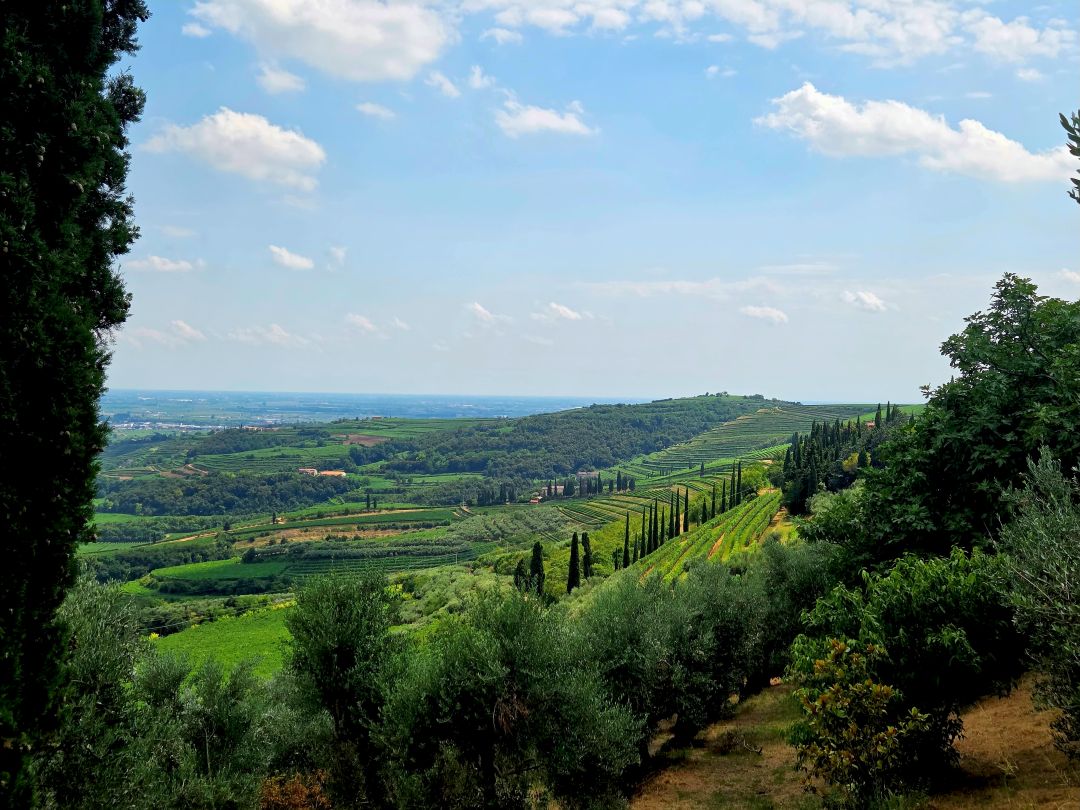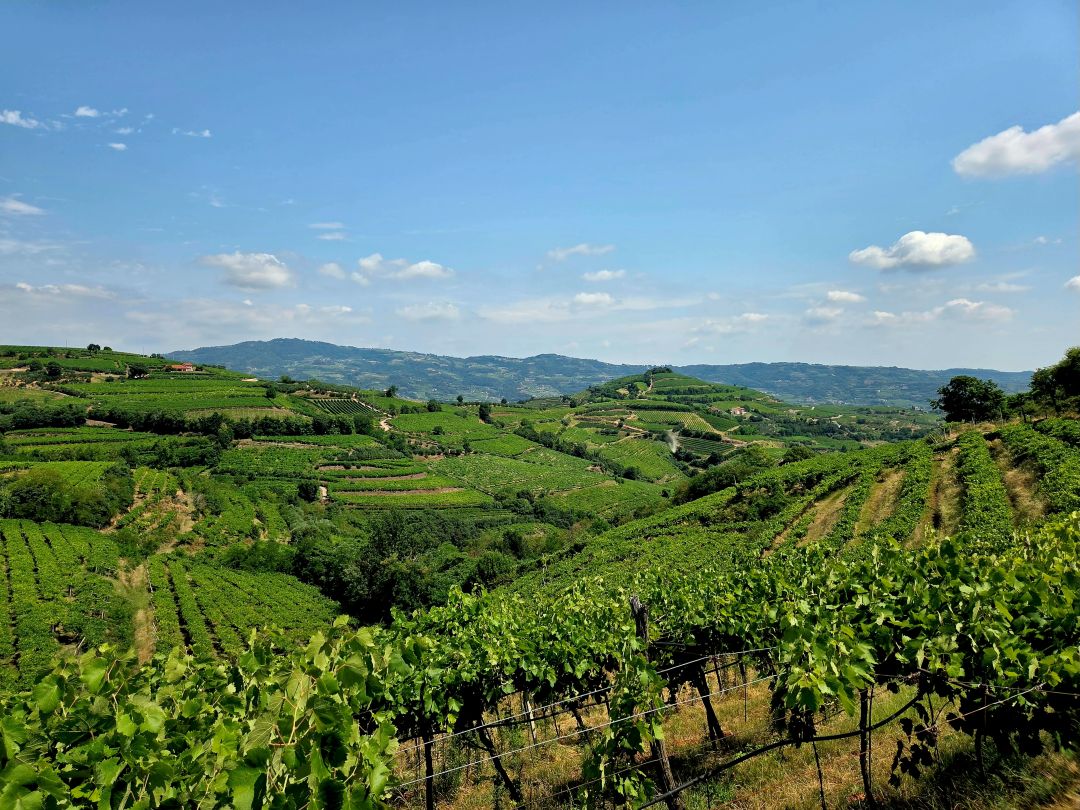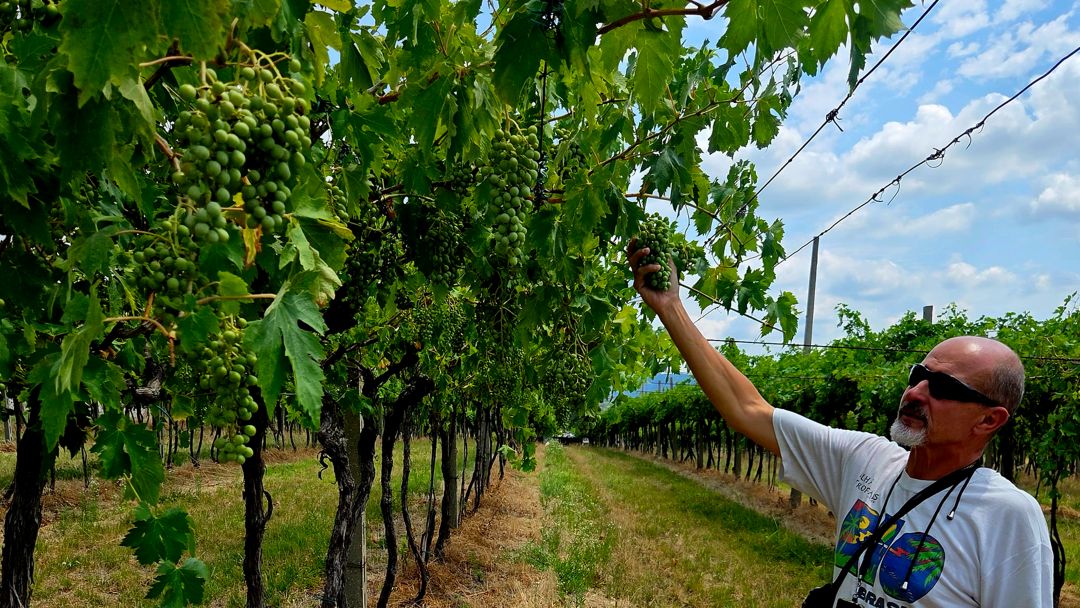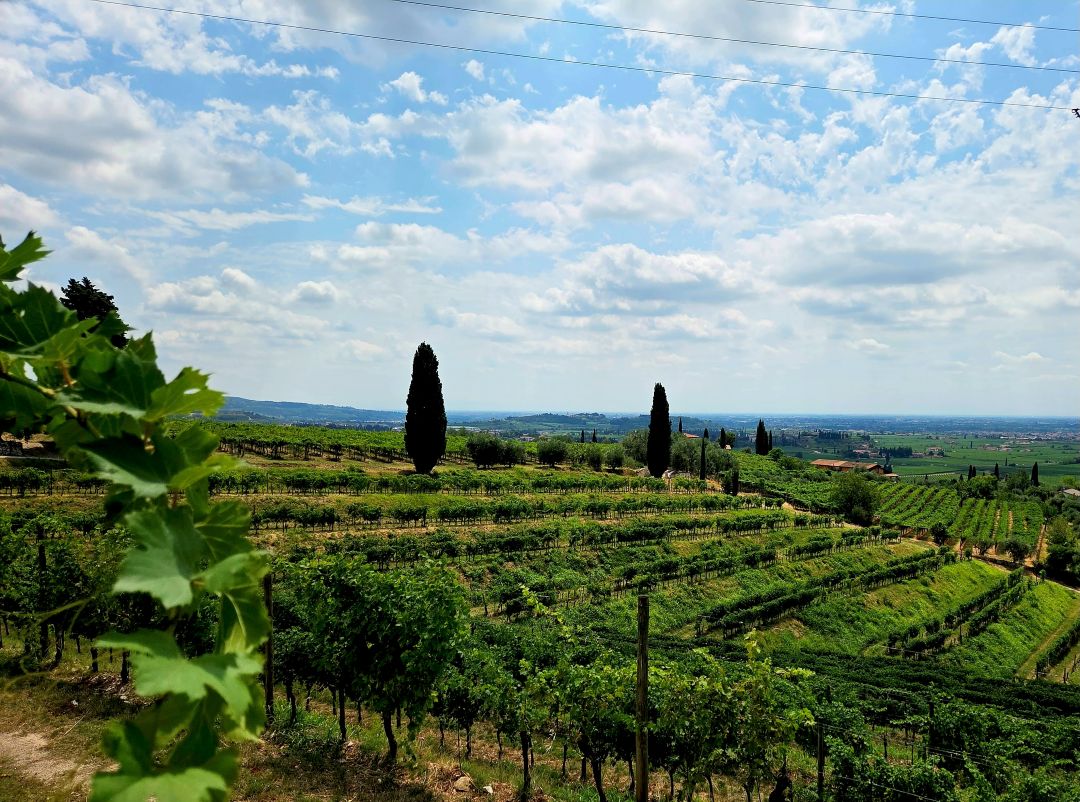Browse using the new Vinous website now. Launch →
Printed by, and for the sole use of . All rights reserved © 2015 Vinous Media
Veneto Rising: Amarone, Soave and Beyond
BY ERIC GUIDO | SEPTEMBER 25, 2025
There has never been a more exciting time to love and collect the wines of Veneto. The region offers something for every palate, traversing multiple styles and numerous varieties. Whether the wines are traditional, modern or experimental, quality has soared well above past levels, all while maintaining reasonable prices.
The selection of exceptional wines from diverse locations across Veneto is almost dizzying. The most widely known region, Valpolicella, spans the three valleys of the Classico zone, the Valpantena Valley and the eastern plains that abut Soave. These areas include a unique selection of elevations and soil types, from volcanic to calcareous clay and alluvial deposits. Here, Amarone, Valpolicella Superiore, Ripasso and Recioto all fit neatly into a spectrum from everyday drinkers to long-term agers.
Then there’s Soave, one of the most popular categories in Italy. Soave spans the extensive plains that give rise to an ocean of easy-drinking wines, but also the volcanic hills of the Soave Classico zone, home to some of the best terroir-focused white wines in all of Italy.
Gaining in both popularity and quality the Lugana DOC delivers fruit-forward yet mineral-driven whites, hailing from clay- and limestone-rich glacial moraine soils off the shores of Lake Garda. Each year, I am more impressed by new offerings emerging from this category.
Let’s not forget Bardolino, the area situated to the west of Valpolicella and focused on the same varieties done in a more approachable style reminiscent of Beaujolais. And now, there’s the newly formed group: Grandi Vitigni Tradizionali del Veneto. For the last few years, I’ve spoken about the growing category of red wines from across Veneto (not from Valpolicella), where varieties like Carménère, Cabernet Sauvignon, Cabernet Franc and Merlot are king. For decades, producers like Maculan, Vignalta and Inama worked diligently to grow consumer awareness of the Colli Berici, Colli Euganei, Montello Asolo and Colli di Conegliano appellations. Today, these producers have organized with other family-run wineries in Veneto to put a name to their campaign. This remains a work in progress outside the long-standing top performers, but the potential is incredibly high. Readers will find notes from all of these areas in this report.

Lake Garda and the mountains to the north provide cooling relief to both Valpolicella and Lugana.
Redefining Amarone and Valpolicella Superiore
I often write about the difficulties winemakers face, typically concerning challenging vintages and severe weather brought about by climate change. As a region, Valpolicella handles these issues well, especially because Amarone, its most famous wine, excels in warm years. However, Valpolicella faces a distinct problem in its top wines: sugar. Conversations about residual sugar in wine are a constant at nearly every one of my tasting appointments in Veneto. The reason for this is the general public’s modern-day awareness of the health risks associated with sugar consumption. Unfortunately, the solution to lowering residual sugar is not just a matter of fermenting more sugar from the wine, as that can compromise balance. Wine is built around a delicate equilibrium of acidity, tannin, alcohol and sugar. If a winemaker ferments out more sugar, it creates more alcohol, which may interact poorly with the acidity or emphasize the tannins, potentially resulting in a beast of a wine that no one would enjoy drinking. Some producers do a fantastic job of achieving this low-sugar balance. Brigaldara, Monte dall’Ora, Speri, Tedeschi and (maybe surprising to some readers) Dal Forno Romano all come to mind.

A range of high-performing Amarone spanning multiple vintages and styles.
A certain amount of sugar, or the perception of sweetness, must remain for an Amarone to taste and perform how one would expect. While these modern-day, low-sugar examples of Amarone are fantastic, they are quite different from the wines of ten to twenty years ago, nearly to the point of needing their own classification. The obligatory question about Amarone is, “What do you pair it with?” For these savory wines, it’s as easy as pairing them with any hearty meal or fatty cut of meat. Moreover, these wines can age just as well as traditional Amarone. I love both styles, which I think is clear from my reviews. However, we are entering a time where some producers are beginning to experiment with their techniques, hoping to emulate the success of others and follow trends, and it doesn’t always go well.
It’s also critical to consider the appassimento process (drying grapes to concentrate their sugars) that creates Amarone, as well as the ripasso process (when a fresh Valpolicella re-ferments in contact with the lees and skins of an Amarone fermentation). Both approaches create glycerol richness and a perception of sweetness in the resulting wines, a trick of the palate and the mind. Just because an Amarone tastes sweet doesn’t mean it contains an elevated amount of residual sugar. Readers will find comments on producers' styles throughout my notes.

The ridge separating the Tramigna and Illasi Valleys at the Trabucchi vineyards, now managed by the Dal Forno brothers.
Another common topic, which winemakers believe is a significant hurdle for younger audiences, is alcohol content. I refer to the microbrewery trend that is all the rage in countries like the United States, and the popularity of IPAs (India Pale Ale) that reach and sometimes exceed 9.5% ABV. The younger generation does not fear alcohol as much as some of my peers believe they do. The topic of alcohol percentage among wine collectors is also widely misunderstood. Anyone who raises an eyebrow at an Amarone at 16-17% ABV may want to consider the alcohol content of their favorite Châteauneuf du Pape or Paso Robles Grenache. Alcohol plays into the same dance of balance I referred to above, and when a wine achieves that perfect harmony, alcohol content is completely unnoticeable. Some producers across the globe have begun using processes to de-alcoholize wines, and the results that I’ve tasted have been unimpressive. I can’t imagine a world of wine without alcohol.
That brings me to Valpolicella Superiore, which many winemakers see as the answer to the questions of both sugar and alcohol. I think they’re right. Instead of dropping Amarone or Ripasso from their portfolios, many producers are seeking to craft wines made from fresh (not appassimento) grapes in an effort to communicate terroir. They believe in the prestige of indigenous varieties— Corvina, Corvinone, Rondinella and Molinara—and their ability to yield high-quality dry wines. I’ve witnessed the emergence of the category firsthand, and this is truly an exciting time for winemakers and consumers. The best Valpolicella Superiores reach the same quality level as wines like Chianti Classico, Etna Rosso and top-level Rosso di Montalcino. These wines represent exceptional value, pair extremely well with a diverse array of cuisines and often have the ability to age. This report is full of great examples from this category.

Undulating hillside vineyards in Soave Classico.
The Trials and Tribulations of Soave Classico
What does Soave Classico have to do to gain the respect it deserves? Incredibly, misconceptions or branding from the past can haunt a winemaking region for decades. The biggest enemy of Soave Classico is Soave itself. Verdicchio from Marche, Etna Bianco, Fiano di Avellino from Campania and the diverse offerings from across Friuli all enjoy worldwide perception as Italy’s top white wines. And while a quick online search will tell you that Soave is better recognized than all of those, that typically refers to an easy-drinking, mass-produced, value-oriented wine from the flat alluvial plains that connect with Valpolicella. That completely overlooks the hills of Soave Classico, a patchwork of terroirs that often play host to ancient vines. While mass-produced Soave (usually blended with Trebbiano Toscano or even Chardonnay) is made for immediate consumption, Soave Classico can age remarkably well.
Soave Classico and its leading producers aren’t content to sit on their hands and hope that the wine-drinking public comes around. Instead, the Consorzio Tutela Vini Soave e Recioto di Soave devised a classification system of 33 crus/UGAs (Unità Geografica Aggiuntiva), allowing producers to label their wines with the specific vineyard source. This gives consumers a better understanding of a wine's origin and distinct character. The Consorzio also published multiple detailed maps that break down soil types, exposures and history. Most importantly, they are now placing more emphasis von blends, focusing more on Garganega and its low-yielding traditional partner Trebbiano di Soave, while moving away from other varieties. Trebbiano di Soave is a high-quality Trebbiano clone that, through DNA analysis, has been connected to Trebbiano di Lugana (which makes Lugana) and Verdicchio. These days, I observe the use of the Soave Classico Superiore DOCG more frequently. This is an excellent sign, because these winemakers are willing to commit to lower yields (10 tons per hectare) and fermenting the wines dry. Readers who enjoy complex, site-transparent, long-lived white wines should add Soave Classico to their cellars

Valentina Tessari of Suavia discussing the importance of place in Soave Classico.
Time to Talk Vintages
Discussing vintages in a Veneto report is always tricky. Despite their proximity, the two major regions of Valpolicella and Soave are remarkably different. The hearty Garganega grape in Soave often resists mildew and mold, while the red varieties in Valpolicella are more susceptible. Adding to the complexity is the staggered release schedule of the wines. This report focuses mainly on Soave from the 2023 and 2024 vintages, while Valpolicella and Valpolicella Superiore are primarily from 2021, 2022 and 2023. Most of the Amarones in this report are from the 2020 and 2019 vintages.
The best news for lovers of Valpolicella is that the 2019s are just as exciting as I’d hoped. Despite the warm conditions of the season, including two heatwaves, the 2019s are vibrant, fruit-intense, structured Amarones that impress with their radiance. Many are built for long-term cellaring, but most are already enjoyable today. I often comment on Amarone's ability to excel through warm vintages, and 2019 is a perfect example of just that.
Many of the 2020 Amarones reflect the season's difficulties through their rich fruit profiles and lack of complexity, but there are still many success stories from this rollercoaster vintage. A series of extreme weather shifts defined the year. A period of intense heat and then cold followed a rainy June, with each month representing a dramatic change from the last. The heat in August caused vines to shut down. However, the most significant challenge of the vintage was hail. While the valleys of Fumane and Marano were spared, the broader Valpolicella area lost fruit from roughly 1,000 hectares of vines. Brigladara winemaker Antonio Cesari explained, "The big problem with 2020 was the hail. Anyone who received hail between June and August may have lost everything. If you didn’t, you could make pretty good wine."
Most of the 2021s in this report are late-release Soave and Valpolicella Superiore, both of which show the year's potential. It was a hot yet balanced vintage without heat spikes and. A temperate harvest season allowed winemakers to make picking decisions based on their desired level of ripeness. I’m excited about the 2021 Amarones, so keep your eyes peeled.
The 2022s come across just as I had predicted: rich, round and viscous. The region experienced drought conditions throughout the season, compounded by warm to hot temperatures. A few things could help in 2022, such as higher elevations, emergency irrigation and pergola vine-training, but overall, the 2022s are more immediate wines. So far, my tastings have revealed more success in Soave than in Valpolicella.

Paolo Fornaser of Monte Faustino speaking about the importance of vine age and Pergola training in Valpolicella.
The 2023 vintage was challenging for winemakers across Veneto, though some fared better than others. While red varieties in Valpolicella struggled, white grapes like Garganega and Trebbiano di Soave proved more resilient. The season began with unseasonably warm temperatures, but a cool, rainy and cloudy spring soon followed, creating ideal conditions for downy mildew (Peronospora). Winemakers were forced to treat their vines constantly, a complicated struggle for organic producers who rely on less aggressive copper and sulfur treatments to maintain compliance. The weather shifted dramatically in July and August, turning extremely hot and dry. This heat stressed the vines, leading to uneven ripening and dehydrated berries. As a result, meticulous selection was crucial during harvest. Luca Speri of the Speri winery noted that an optical sorter was essential for ensuring only healthy fruit entered the winery, leading to a 10-15% reduction of their total production. However, in Soave, winemakers reported an easier time. The region's well-draining volcanic soils, combined with the natural mold-resistance of Garganega, helped protect the vineyards from the worst of the mildew.
The 2024 vintage was extremely difficult, as witnessed in many of the young Soaves I tasted for this report. A large portion of these wines show signs of dilution and greenness, lacking in overall complexity. Even the resilient Garganega grape, known for its resistance to mold and disease, succumbed to Peronospora during the harvest. The season started with balanced precipitation in the spring. A classic hot, dry July and August led many to anticipate an excellent vintage. However, the weather took a turn for the worse in late September with an extended period of cool, wet conditions. Rain lasted through harvest, forcing wineries to pick between storms and making it nearly impossible to achieve full physiological ripeness. The persistent moisture caused Peronospora to spread rapidly, followed by the onset of rot within the grape bunches. Matteo Inama, winemaker at Inama, described the unprecedented challenges: “I’d never seen Garganega rot until 2024. The grapes went from green to yellow, then to a shade of violet, the first sign of noble rot, but it was quickly moving toward a bad rot. We were rushing to pick on an emergency basis.” As a result, readers should expect a significant reduction in production, with totals down by approximately 25-30%. The quality of the 2024 wines will largely depend on a producer's willingness to make difficult decisions and adapt. At Inama, for example, all lots were kept separate, pulled off the lees early and blended only after ensuring the juice's purity. I anticipate 2024 will be a highly variable throughout Veneto, and I will update readers on the status of the red wines as they are released.

Looking out across San Pietro in Cariano within the Valpolicella Classico area.
I tasted the wines in this report during producer visits throughout Veneto in July 2025.
© 2025, Vinous. No portion of this article may be copied, shared or redistributed without prior consent from Vinous. Doing so is not only a violation of our copyright but also threatens the survival of independent wine criticism.
You Might Also Enjoy
Veneto: A Constant State of Evolution, Eric Guido, February 2024
Veneto: The Land of Opportunity, Eric Guido, March 2023
On the Cusp of Evolution: Amarone and Valpolicella, Eric Guido, April 2022
Soave - The Long Road Home, Eric Guido, April 2022
Show all the wines (sorted by score)
- Allegrini
- Antiche Terre Venete
- Bertani
- Bolla
- Brave Wine Società Agricola
- Brigaldara
- Ca' La Bionda
- Ca' Lustra di Zanovello Franco
- Cà Maiol
- Camerani - Adalia & Corte Sant'Alda
- Ca' Rugate
- Case Paolin
- Castellani Michele
- Cavalchina
- Cavazza
- Cecilia Beretta
- Clivus
- Coffele
- Collalto
- Corte Adami
- Corte Figaretto
- Corte Mainente
- Corte Moschina
- Costa Arènte
- Dal Forno Bros. - Comaroto
- Dal Forno Romano
- Dal Maso
- Dama Del Rovere
- Damoli Bruno
- Domini Veneti
- Emo Capodilista / Montecchia
- Farina
- Fattori
- Filò delle Vigne
- Giannitessari
- Gini
- Giusti Wine
- Guerrieri Rizzardi
- Il Mottolo
- Inama
- I Stefanini
- La Cappuccina
- La Collina Dei Ciliegi
- L'Arco
- Le Battistelle
- Loredan Gasparini
- Lorenzo Begali
- Maculan
- Marion
- Masari
- Masi
- Massimago
- Miotti
- Monteci
- Monte Dall’Ora
- Monte Del Frà
- Monte Faustino
- Montetondo
- Musella
- Nardello
- Nicolis
- Ornella Molon
- Pasqua Wines
- Pieropan
- Piovene Porto Godi
- Portinari
- Prà
- Quintarelli
- Roccolo Grassi
- Rubinelli Vajol
- Santi
- Serafini e Vidotto
- Sorelle Bronca
- Speri
- Suavia
- Tedeschi
- Tenuta La Presa
- Tenuta Santa Maria
- Tenuta Sant'Antonio
- Tommasi
- Tommaso Bussola
- Torre D'Orti
- Trabucchi d'Illasi
- Vignalta
- Vigneti Di Ettore
- Zenato
- Zýmē
